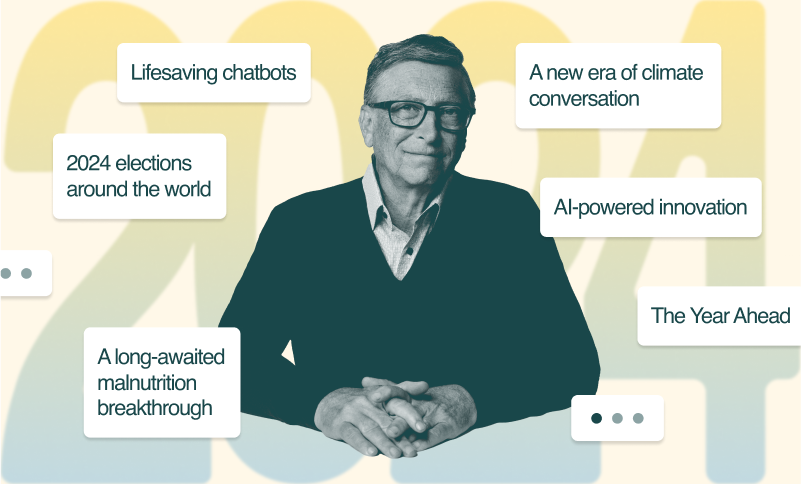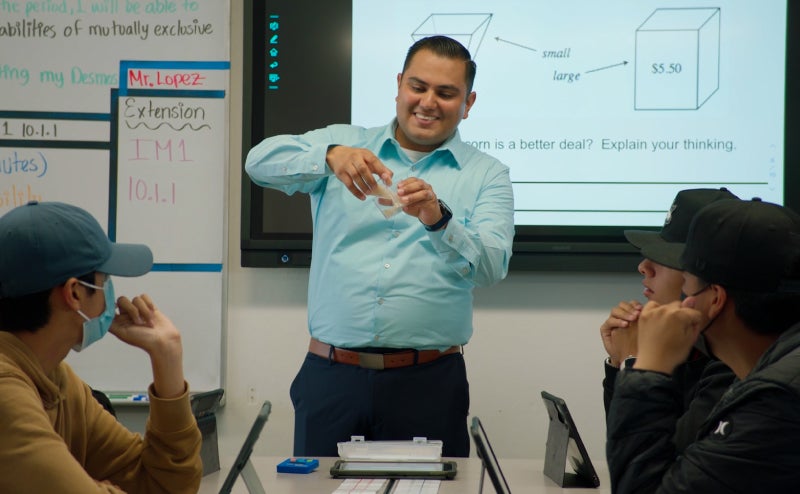Every teacher deserves the chance to be phenomenal.
It’s easy to say, and I don’t know anyone who would disagree with the sentiment. But in the history of American education, this vision has proven hard to deliver on. Whenever I talk to teachers, one of their biggest concerns is that they don’t have the tools they need to do their best work. We see the same results in polls of teachers.
I’m optimistic that all of us who are passionate about education can solve this problem. One of the main reasons I’m so hopeful is that advances in technology will make it easier to give teachers the support they deserve. For example, teachers will be able to upload videos of themselves and get advice from their peers, watch the best teachers in the world at work, and get real-time feedback from their students. Software will also help identify which students are having trouble and adjust for their own learning style, leaving teachers more time to focus on the kids who need extra personal attention. (I wrote in more detail about how software will improve education worldwide in last year’s Annual Letter.)
Developers will play a key role in making these advances. I recently had a chance to talk with a number of the leading companies doing this work when I spoke at the ASU GSV Summit, an education-technology conference in San Diego, California. I encouraged them to work more closely with teachers to understand their needs, and to make sure their products deliver measurable results in the classroom. Technology can revolutionize the way teachers and students work together—but only if we base our approaches on evidence about what works.
Below you can read the transcript of my onstage Q&A. I also gave a speech. There’s a lot of exciting work going on in this field, and I definitely left San Diego feeling better than ever about the potential for technology to support teachers and students in a big way.
ASU GSV Q&A
QUESTION:
You have concerns about the pace of change and about whether we’re making adequate impact quickly enough and I’m just curious if you have advice for the entrepreneurs out there as they think about it. How do we accelerate this pace and have bigger impact on the students?
BILL GATES:
Well, in the K-12 area, the way the products are selected, the way money is budgeted for those, over time, that’s really got to change. We’ve got to free up more of the professional development money. We’ve got to get some example products that are clearly so successful that it really opens peoples’ minds to what the role of technology here is. I’d say we’re pretty early in that process.
There are a lot of teachers who are willing to be the pioneers in this area—that’s where we’ve gotten the adoptions so far. There are a lot of cases where we try and go beyond and get a district-wide adoption. We really have to look at why the uptake by the actual usage isn’t quite there, because then that creates something that other people hear about and they’re very, very reluctant.
We do have the benefit though—the digital tools now with the combination of PC, tablet, and cell phone. The three of those we’re close to universality. The idea that the connection was holding things back or access to a device is holding things back—those haven’t gone away, but particularly if some of the experience can be done on a small screen—then even when you get outside the United States the access levels are starting to be a lot higher.
There’s a very positive framework. There’s a sense of need, you know, as people look at those college residence numbers, they look at those completion numbers, and the whole cost equation, higher education is really staring at a tough set of constraints. So that should serve to drive the demand.
QUESTION:
It feels to me like we’re hitting a proverbial tipping point in the embrace of personalization and a better understanding of what adapted means, personalized means. What do you see over the next five years? What’s your prognosis both in K-12 and for higher ed actually?
BILL GATES:
Well, personalized learning is a fairly clear definition. But I think there are different things that come under that umbrella.
Math is the most straightforward because the idea of assessing knowledge very efficiently and saying, “OK, if you really can answer those questions, then we’ll move on to the other area.” That’s far more concrete than say, writing or history.
I was pretty amazed in my last visit to Summit to see how they have taken all the different areas and really given the students a sense of some degree of choice in what they’re doing and a real sense of what they need to get done.
The idea of an agency—where the student knows how much they have to get done, they’re making some selections there that really creates a different relationship between the student and teacher. So I’m hopeful that for math, we can get a very broad rollout of that within the next five years.
It does require the schools to be open-minded because when you go to those new classrooms’ locations, they’re not just in a typical classroom. They’ve been allowed to remodel some of that space. So the kids are moving around and it’s quite amazing. But there was an upfront investment there and a decision to get all the teachers engaged in that new model.
It’s a lot easier if you can do the current physical classroom teacher by teacher. Some stuff fits into that. But the biggest impact is where you can make changes in those things as well—it’s a school-wide way of doing things.
As you get up into higher-ed, it’s a lot more straightforward because then there’s an assumption that, largely, the student is motivated. The student knows what they’re doing. And it is there (in higher-ed), the interactivity, the personalization—particularly in the remedial courses where we’ve gone the furthest—that we’ve seen a dramatic payback in.
QUESTION:
We have a section called “Tomorrowland” at the Summit this year. Do you think the embrace of these new technologies—virtual reality, augmented reality—are going to accelerate the adoption of personalized learning?
BILL GATES:
Yes, I think virtual reality can make things more engaging. And there are certain things where you have more of a sense—even if you can't, say, build a car in the virtual world, you can sit there and put the pieces together and almost feel like you're doing far more than would be practical in the real world.
There's a lot of pedagogy about understanding the science and the math (principles) that really won't change much just because we put it in a virtual reality framework.
School is always about motivation. The material has been in the textbooks for a long time. In some subject areas, it hasn't even changed that much. If we can use it to draw people in, then that's incredibly valuable.
I'm just starting this for some of the videos I do—like where I go out to a refugee camp or to a developing country, to actually make a virtual reality movie. So people actually have a sense so they can see what it was like and look around and feel it.
And yes, we see it as we're creating those early stage things. We see a lot of engagement. And so combining that with the underlying concepts and not just having it be a distraction.
In learning science, there are a lot of things about—you make things too animated, too colorful, things like that—it often distracts from what you're really trying to get done, which is the attention to a few basic concepts. So I'm sure we'll be able to abuse virtual reality as well as we have ANY new technology that's out there.
I do think in terms of design, lots of engineering things, there's lots of places where it will play a practical role and hopefully draw people in.
And the cost—particularly where you're just taking the cellphone and repurposing that—we won't have to wait a whole decade before the accessibility is there for the lower-end versions of this. The higher-end versions—having an environment where you spend the $500-$1,000 and have it as a shared device—we should have that in a lot of locations as well.
QUESTION:
One of the things I most admire about you and Melinda are that you’re proactive. You’re avid visitors. You visit schools. You’ve talked about some of them a number of times already. You visit schools. You visit universities. What’s the key takeaway you’ve seen in the most recent period in terms of your visits? What are you hearing from educators on the ground that you’re incorporating into your work?
BILL GATES:
Well, it’s been very interesting to learn about who online (learning) is working for. And so far, a lot of the people who are engaged online are more of these adult students who are tougher because their scheduling is more difficult, but they’re easier because they come back for a reason. That is, they’re self-selected that, “OK I want to become a nurse.” “I want to get this engineering degree.”
And so, online, because it fits into that time flexibility and because they’re willing to persevere—that’s been the initial audience that that’s worked well for.
But there are people now, including ASU, who are using it for other cohorts. And they’re taking the very latest, which is far more engaging content than we’ve had in the past, and trying to make it work for everyone.
I think in education, there’s two types of visits you can do. When you get discouraged and don’t think that anything can happen—then you’ve got to go visit KIPP or Green Dot, or High Tech High, or Summit, and see classrooms—or Rocket Ship, which actually is doing some very interesting things.
Go to one where it all really came together: great teachers, a new approach, and you get reminded, “Wow—if we could do this for every student this would be phenomenal!” Then if you ever think, “Oh boy! This is great.” Then go and visit a college that has a 19 percent completion rate or go to an inner-city high school and get a sense of the disengagement that’s there and the amount of resources that’s just going to make sure that the environment is secure.
And so we have plenty of opportunity to see both of those. I do more visits to the ones that are doing well, because those are the best practices we want to spread.
My most recent trip this fall was to Appalachia and I thought that would be a mix. But because Kentucky has invested in their schools over the last 10 years, what we saw was mostly uplifting. These are public schools, very low-income kids, and the way those communities have come together around some of the new curriculum, better professional development, was really inspiring. So that gives you maybe a year or two of motivation you need to do it even more.





